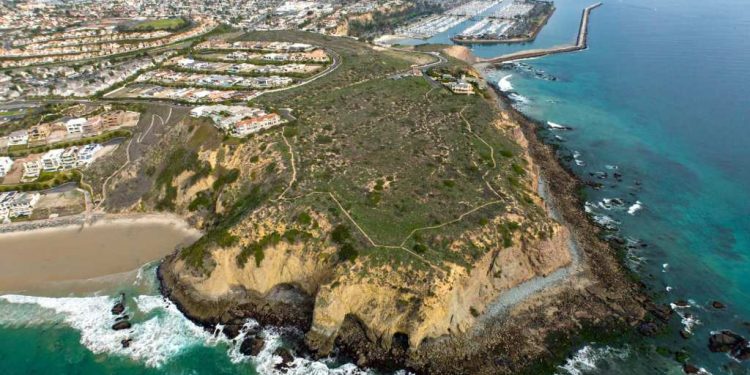An environmental group that manages land on Dana Point’s promontories – one of the three places in California where the Pacific pocket mouse is located – has submitted a plan to reduce the hours that the public can use the path.
The top trail bluff along the crest of massive rocky outcrops is popular to see marine life and sea birds in the ocean below in a city brand as the world capital of dolphin and whales. The trail, now open daily from sunrise to sunset, takes visitors beyond the coastal sage brush and other natural vegetation that houses mice – in 2022, 77 counted – and the Moucheron mill of California threatened.
But for years, there has been a rope fight between the management of the Center for Natural Lands and the city on the amount of public access which should be authorized. The center wants to reduce use to four days a week and set hours that prevent people from being present during low light times when the mice are more likely to be above the ground.
The city, which obtained a servitude for the path when home development was authorized to Strand Beach nearby, says that the public should be able to enjoy the field and Vista seven days a week. In 2022, an order of the court granted daily use and, in May, the city planning committee solidified these hours by delivering a permit.
The center responded with its own permit application, which included more than a hundred pages of documentation pleading to reduce access. The city has been examining it since October.
Recently, the planning committee has agreed that enough information has been provided to advance it and, pending certain additional environmental studies, it is now likely that the Commission could examine the center’s request for more limited access to the start of the summer. Center managers qualified the delay in dropout tactics.
“I am inclined to continue to move forward,” said Commissioner Eric Nelson, adding that the path above the Pacific Ocean is on approximately 1% of the land put aside as part of the development and conservation plan for promontories and conservation when the houses were built on Stand Beach. “The path had to maximize public coastal access.”
Nelson said only to make the city change the hours of the trail, no more examination is necessary to see how critical of the Daily Times to allow people to travel on foot from the port to Salt Creek Beach.
“This is a 60% reduction in overall use,” said Nelson, referring to the center’s proposal. “This is a significant decrease in access to a public resource.”
Although the commissioners can consider the proposal of the center as a violation of the use of the public, non -profit leaders say that their plan is necessary to provide a more ideal habitat for the endangered pocket mouse exists and reproduce.
The only other places where the pocket mouse now exists are now on the Pendleton camp and in the wild park of Laguna Coast, where mice raised at the San Diego zoo have been released. In 2017, studies of the new population showed that they had started to reproduce independently.
“We are delighted that the call (Center for Natural Lands Managment) was granted,” said Sarah Mueller, a lawyer for the non -profit organization, but added that it was unhappy that the city has not evolved more quickly and that the group is concerned with continuous delay and that the daily presence of the public collects things for the effort of conservation.
“(The request of the Center for Natural Lands Managment) should have been deemed complete last year,” she said. “It seems to be another tactic in the city to badly delay any decision on the hours of the CNLM track.”
City officials argue that the center must examine its management of the reserve of promontories and do more to improve the population of the pocket mouse before considering the trails. They call the path an “important the coastal equipment using visitors”.
According to Mueller, CNLM follows the mice and the data that already help to understand how the population is going. They also follow the number of people crossing the doors of the reserve and the path. By putting information together, the group is more concerned with use on the mouse population, said Mueller.
With a subsidy from the Steel Foundation, the center bought the land from the developer Sanford Edward in 2005 for $ 11.9 million to preserve the open space on promontories. The group also received $ 800,000 from the Ministry of Defense as an attenuation of basic impacts on the mouse population.
CNLM is responsible for daily conservation and management, and the public track, for which the city has a servitude, must be accessible.
The path opened in 2009 and had the same public hours until the start during the pandemic when CNLM closed it. Once it reopened, access was limited until 2022.
California Daily Newspapers


